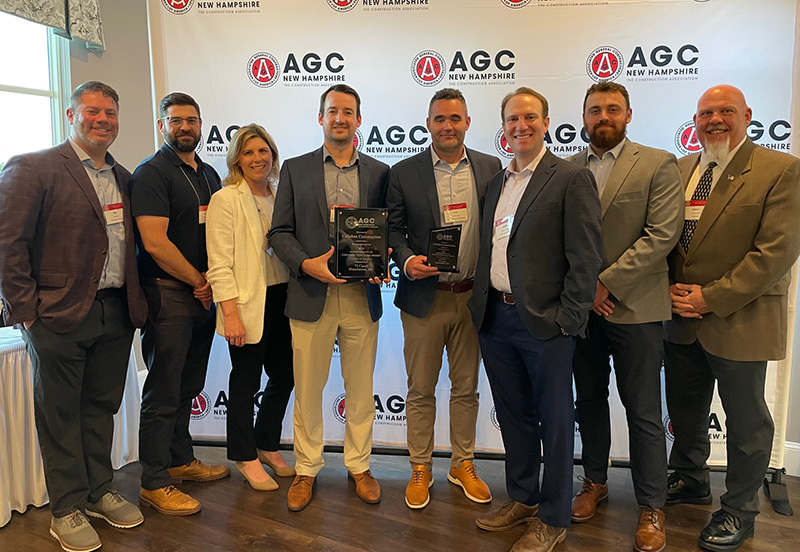News: Construction Design & Engineering
Posted: September 20, 2012
Tocci Building Cos. substantially completes historical renovation at Abbot Mill in Forge Village for Yule Development: project team includes: Barry Ganek Archts., Sousa & True, and MacRostie Historic Advisors
Tocci Building Cos. said that the main building of the Abbot Mill renovation in Forge Village is substantially complete. Originally built in 1870 and now owned by Yule Development, the 239,000 s/f project is part of the history of industrial Massachusetts. The residential complex includes a main mill and five out buildings totaling 131 units, 13 of which are affordable housing. The project team recently celebrated its grand opening.
The renovated main building with its signature bell tower marks the rejuvenation of Forge Village. Once a busy fabric mill, Abbot "Worsted" changed hands several times throughout the last 50 years and eventually fell into disrepair. Together with Yule Development, Tocci restored this important landmark and transformed it into living spaces reflecting the mill's rich past while adhering to current sustainable building practices.
Many features of the original Victorian building were either restored or replicated. For example, boarded-up saw-tooth skylights, originally constructed to draw natural light into interior spaces for mill workers, once again allow light to flood common areas and apartment units.
The owner of Yule Development, Chris Yule, initiated several changes to increase sustainability throughout the project. Solutions were found to dramatically limit heat and cooling loss, including sealing and insulating each unit. Whenever possible, materials were re-used on-site rather than thrown away. Lumber off-cuts were used as the stairs risers. Steel plates that once reinforced the mill floor were transformed into unit signs.
A primary sustainable feature is 40,000 s/f of solar panels on the roof, producing 331KW of non-carbon energy. The renovation kept heat exchangers in place, continuing to use canal water for heating and cooling. In his green endeavors, Yule hopes to restore the original hydroelectric generator beneath the building to produce electricity.
The rich mill history includes several owners: Abbot Worsted Mills was sold to Murray Printing and then to Courier Printing. When their needs changed, owners built additions based on function with little regard for architectural integrity. During renovations, Tocci encountered numerous challenges posed by the sheer variety of these additions: brick, timber and concrete construction, varying floor levels, and confined spaces.
"Tocci's historical renovation and construction expertise have been fundamental to this project," said Chris Yule. "My main objective was to preserve the historical context of the building while creating an energy efficient, modern living environment that complements today's aesthetics. Tocci's flexibility and advanced array of services have been instrumental in achieving that goal."
In addition to the superintendent, Tocci put an assistant superintendent on-site to support construction management and use virtual design and construction (VDC). His dual role led a pilot program of atomization, furthering Tocci's BIM technology. At its core, atomization takes people out of the office and embeds them in a construction site to use 3D tools every day and involve the trades. At Abbot Mill, while a lot of the construction coordination was done manually, much of the mechanical coordination was done with 3D modeling.
Renovation activities were filmed during construction, and a video is available on youtube. To learn more about the mill, please visit Yule Development. In addition to Tocci, the project team included Barry Ganek Architects, Sousa & True Structural Engineers, MacRostie Historic Advisors, and HW Moore Associates, site engineers.
The grand opening ribbon was cut by Helena Crocker and Chris Yule, owner of Yule Development. Crocker grew up in Forge Village, once worked in the mills, and is currently chairman of the Council on Aging.
MORE FROM Construction Design & Engineering
Nobis Group awards Robinson and Moreira STEM scholarships
Concord, NH Nobis Group, a 100% employee-owned consulting firm specializing in engineering and environmental solutions across the Northeast, has named the recipients of its 2025 STEM Scholarship: Andie Moreira of

Quick Hits
Columns and Thought Leadership

Ask the Electrician: Is summer a prime time for commercial electrical maintenance?
The answer is “Yes!” While January marks the official new year, many businesses view September as a fresh start. This makes summer an ideal time for commercial property owners to schedule long-term electrical maintenance projects.

The rise of incubators and co-working spaces: The latest in life sciences - by Matt Combs
In recent years, the life science industry has witnessed a shift in how companies operate and innovate. One of the key driving forces behind this transformation is the emergence of incubators and co-working spaces specifically tailored to meet the unique budget and schedule needs of startups.

The design-build advantage: Integrated interior design solutions - by Parker Snyder
When it comes to corporate interior spaces for both commercial and industrial projects, partnering with a design-build firm with in-house interior design services can offer clients many benefits. Unlike traditional delivery methods where interior designers operate independently from the design and construction teams, often creating a longer project timeline as cost negotiations and revisions ensue

Careers in Construction Month focus on training and safety - by Joe Camilo
October is Careers in Construction Month, and rarely has it been more consequential. According to our chapter’s national parent organization, the construction industry needs to attract half-a-million new workers in the coming year to meet demand. Addressing that need is a huge job, but we at ABC MA are trying to do our part.







.png)